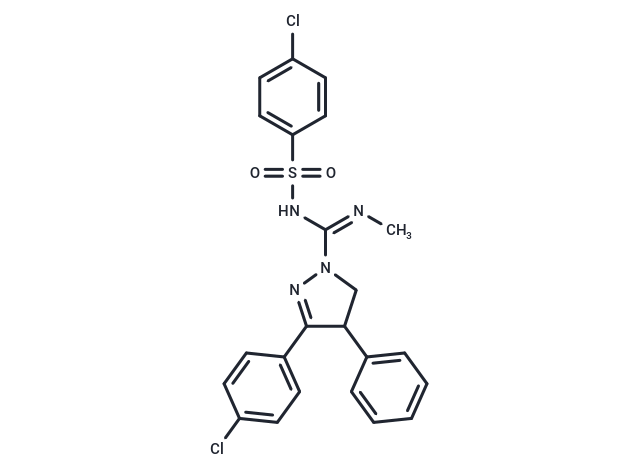Shopping Cart
- Remove All
 Your shopping cart is currently empty
Your shopping cart is currently empty
(±)-Ibipinabant ((±)-SLV319) has been utilized in clinical trials for the treatment of obesity and type 2 diabetes.

| Pack Size | Price | Availability | Quantity |
|---|---|---|---|
| 5 mg | $43 | In Stock | |
| 10 mg | $83 | In Stock | |
| 25 mg | $167 | In Stock | |
| 50 mg | $308 | In Stock | |
| 100 mg | $446 | In Stock | |
| 200 mg | $619 | In Stock | |
| 1 mL x 10 mM (in DMSO) | $47 | In Stock |
| Description | (±)-Ibipinabant ((±)-SLV319) has been utilized in clinical trials for the treatment of obesity and type 2 diabetes. |
| Targets&IC50 | CB1 :22nM |
| In vitro | Cannabinoid receptor 1 (CB1R) antagonists are promising for obesity treatment, but adverse effects limit clinical use. Ibipinabant is a potent [Ki (CB1) = 7.8 nM] and selective [Ki (CB2) = 7.943 nM] CB1 antagonist, demonstrating in vitro properties similar to rimonabant, including inverse agonism, brain penetration[3], and high affinity [pA2 for arachidonic acid release in CHO cells = 9.9]. |
| In vivo | Ibipinabant (3 mg/kg) significantly lowers unfasted glucose levels compared to rimonabant at equivalent doses on days 17, 28, and 38. Long-term ibipinabant administration notably slows diabetes progression in ZDF rats by moderating the rise in blood glucose and HbA1c levels over time. Additionally, ibipinabant decreases the evident hyperinsulinemia at 6-8 weeks of age and mitigates the sharp decline in insulin levels occurring 1-2 weeks thereafter[3]. |
| Animal Research | Rats: SLV319, rimonabant and rosiglitazone are suspended in a 10% dimethylacetamide, 10% cremophor, 10% ethanol and 70% water vehicle. Drugs are administered by oral gavage in a volume of 2 mL/kg body weight at 09:00 hours every day. Treatment groups are as follows: (i) Vehicle: ad libitum access to food (vehicle), (ii) Vehicle: restricted access to food (20% less than average food intake of ad libitum vehicle-treated group for the first 3 days of the study, then 10% less than the average food intake of the ad libitum vehicle-treated group for the remainder of the study) (restricted), (iii) Rosiglitazone (4 mg/kg), (iv) Rimonabant (3 mg/kg) (RIM 3 mg/kg), (v) Rimonabant (10 mg/kg) (RIM 10 mg/kg), (vi) SLV319 (3 mg/kg) (IBI 3 mg/kg) and (vii) Ibipinabant (10 mg/kg) (IBI 10 mg/kg). Rosiglitazone is used as a positive control for its ability to delay β-cell decline, and rimonabant is used as a positive control for CB1 antagonism[3]. |
| Synonyms | SLV319, (±)-SLV319, (±)-BMS6462 |
| Molecular Weight | 487.4 |
| Formula | C23H20Cl2N4O2S |
| Cas No. | 362519-49-1 |
| Smiles | C\N=C(\NS(=O)(=O)c1ccc(Cl)cc1)N1CC(C(=N1)c1ccc(Cl)cc1)c1ccccc1 |
| Relative Density. | 1.38 g/cm3 (Predicted) |
| Storage | Powder: -20°C for 3 years | In solvent: -80°C for 1 year | Shipping with blue ice/Shipping at ambient temperature. | ||||||||||||||||||||||||||||||
| Solubility Information | DMSO: 45 mg/mL (92.33 mM), Sonication is recommended. | ||||||||||||||||||||||||||||||
| In Vivo Formulation | 10% DMSO+40% PEG300+5% Tween 80+45% Saline: 2 mg/mL (4.1 mM), Sonication is recommended. Please add the solvents sequentially, clarifying the solution as much as possible before adding the next one. Dissolve by heating and/or sonication if necessary. Working solution is recommended to be prepared and used immediately. The formulation provided above is for reference purposes only. In vivo formulations may vary and should be modified based on specific experimental conditions. | ||||||||||||||||||||||||||||||
Solution Preparation Table | |||||||||||||||||||||||||||||||
DMSO
| |||||||||||||||||||||||||||||||

Copyright © 2015-2025 TargetMol Chemicals Inc. All Rights Reserved.